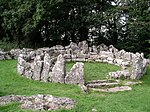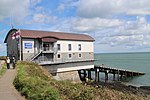Royal Charter (ship)

The Royal Charter was a steam clipper which was wrecked off the beach of Porth Helaeth in Dulas Bay on the northeast coast of Anglesey, Wales on 26 October 1859. About 450 lives were lost, the highest death toll of any shipwreck on the Welsh coast. The precise number of dead is uncertain as the complete passenger list was lost in the wreck, although an incomplete list (not including those who boarded just before departure) is retained in the Victorian Archives Centre in Victoria, Australia. The Royal Charter was the most prominent among about 200 ships wrecked by the Royal Charter Storm. The Royal Charter was built at the Sandycroft Ironworks on the River Dee and was launched in 1855. She was a new type of ship, a 2,719-ton iron-hulled steam clipper, built in the same way as a clipper ship but with auxiliary coal-fired steam engines which could be used in the absence of suitable winds.The ship was used on the route from Liverpool to Australia, mainly as a passenger ship although there was room for some cargo. There was room for up to 600 passengers, with luxury accommodation in the first class. She was considered a very fast ship, able to make the passage to Australia via Cape Horn in under 60 days.
Excerpt from the Wikipedia article Royal Charter (ship) (License: CC BY-SA 3.0, Authors, Images).Royal Charter (ship)
Geographical coordinates (GPS) Address Nearby Places Show on map
Geographical coordinates (GPS)
| Latitude | Longitude |
|---|---|
| N 53.371388888889 ° | E -4.2555555555556 ° |
Address
Moelfre
LL72 8LW
Wales, United Kingdom
Open on Google Maps









